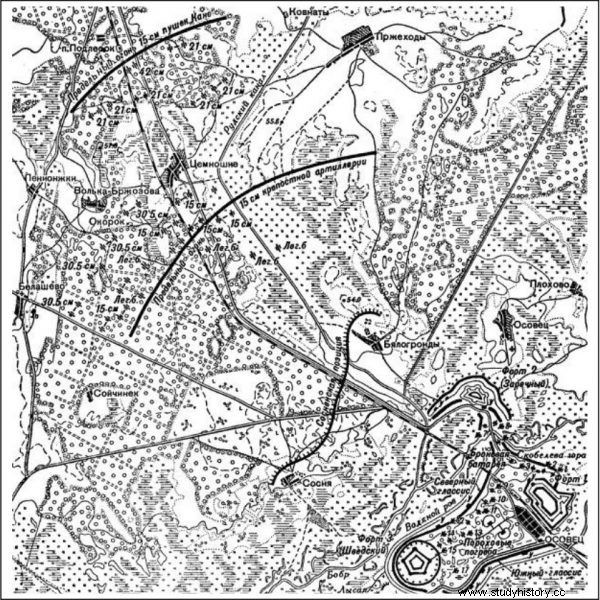The poison gas cloud moved slowly, pushed by the morning summer wind. She killed everything in her path. So when the German soldiers walked along the path trodden by death, and the bullets and blades of their bayonets began to pierce their bodies unexpectedly, they thought that the dead had risen to take revenge for their crime. The defense of the Osowiec Fortress in 1915 was so macabre that to this day it causes fear and reminds of the brutality of war.
The Osowiec Fortress is located in the Podlaskie Voivodeship, on the Biebrza River, approx. 50 km north-west of Białystok. Before Poland reappeared on the map of Europe, it served Russia to strengthen the border with East Prussia. In 1914, it found itself on the eastern front line. The first siege of Osowiec took place on September 20, 1914. On that day, the infantry was supported by heavy artillery fire, but it did not bring any results. The second attempt was made on January 30, 1915. The exhausting siege lasted almost eight months. Frustrated with the lack of success, the Germans finally reached for a new weapon, which they had already tested, among others, under Ypres - war gases.

Gas attack on the Eastern Front
Killer Gas
The third attack took place on August 6, 1915. The fortress was defended by the 226th infantry regiment, supported by militia units, a total of about 900 men. They were against as many as fourteen infantry battalions, about 30 heavy siege guns, as well as 30 artillery batteries, equipped with gaseous chlorine and bromine compounds. The offensive was commanded by Field Marshal Paul von Hindenburg, future president of the Weimar Republic and the Third Reich.
The gas he chose to use combines with the moisture in the lungs, eyes and mucous membranes to turn into hydrochloric acid, which dissolves the body from the inside . However, it is easy to defend against it. A tight gas mask should protect people from any harm. However, after months of besieging the fortress, one thing the Germans knew for sure - the Russians were not equipped with masks.
The day was windy. But the wind alone was not enough. Conditions were needed which could make an involuntary partner in crime in nature. After ten days of waiting, she decided to cooperate. It was blowing exactly from the village of Sośnia towards the fortress. At four in the morning the roar of the siege cannons ceased. There was an ominous silence. Then the gas attack began. Eight kilometers wide, green and yellow mist with a strong, bleach-like scent clouded the horizon. She was bringing death with her . She murdered almost everything within her reach.

Vladimir Karpovich Kotlinsky - fortress defense commander
One of the few survivors, Sergei Khmelkov, recalled:
All the living standing in the foreground were gasified to death. The grass turned black. Fallen flower petals lay everywhere.
Birds were falling from the sky. The leaves on the trees immediately turned yellow and fell. Roe deer, mice, and humans fell in agonizing agony, suffocating through their dissolving lungs, bleeding from their nose and eyes. Desperate, the soldiers tried to save themselves by tying wet rags around their faces. The entire crews of the 9, 10 and 11 Russian companies died at once. Step by step behind the gas cloud, around 7,000 soldiers from over a dozen battalions of the Landwehr's 11th Division were walking with the uncomplicated task of finishing off those who were reluctant to die.
Attack of the dead
Of all the defenders of the fortress, only a hundred survived the gas attack. They were in an almost agonizing state. Among them was second lieutenant Vladimir Kotlinski. He gathered the survivors and presented them with a desperate counterattack plan, after all, they had nothing left to lose.

"Osowiec Fortress" badge
When the Germans crossed the first line of Russian defense and breached the ramparts of the fortress, sixty surviving soldiers ran out to meet them. They presented a terrifying sight. Their skin was burnt, their faces were covered with bloody rags. Their throats, instead of the exhilarating "hurray", only escaped a choking cough as they literally spat out bits of their lungs.
I cannot describe the anger and fury that engulfed our soldiers as they headed towards their poisoners, the Germans. Rifles, machine guns, and heavy shrapnel were not able to stop the attack of the maddened soldiers
- recalled in 1915 for the newspaper Życie Pskowa, an unknown veteran of these clashes. The Germans were terrified. It was as if the dead bodies had risen from their graves to take revenge for their crime . In disarray and disorder, they began to retreat, abandoning their weapons. During the escape, some of them stumbled onto hand-mounted barbed wires, making them easy targets for Russian rifles and bayonets. Many died (how many are not known exactly today). The commander of the "attack of the dead", Kotlinski, died as a result of his injuries .

Battle plan
The Russians managed to defend the Osowiec Fortress. But they knew that they would not be able to hold it any longer. Soon an evacuation order was issued and it was quickly carried out. A great facilitation for the retreat was the temporary chaos that prevailed in the enemy ranks. The retreating soldiers blew up the fortress, depriving it of any strategic value for the enemy.
